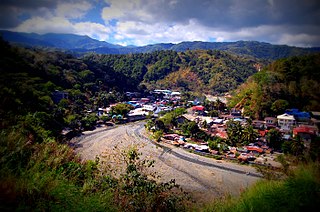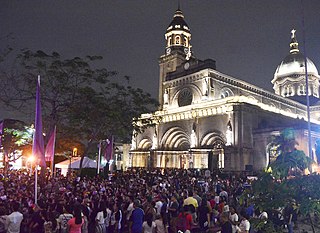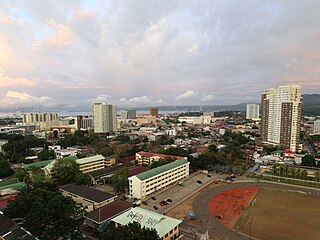
Misamis Oriental, officially the Province of Misamis Oriental, is a province located in the region of Northern Mindanao in the Philippines. Its capital, largest city and provincial center is the city of Cagayan de Oro, which is governed independently from the province.

Isabela, officially the Province of Isabela, is the second largest province in the Philippines in land area located in the Cagayan Valley. Its capital and the largest local government unit is the city of Ilagan. It is bordered by the provinces of Cagayan to the north, Kalinga to the northwest, Mountain Province to the central-west, Ifugao and Nueva Vizcaya to the southwest, Quirino, Aurora and the independent city of Santiago to the south, and the Philippine Sea to the east.

Nueva Vizcaya, officially the Province of Nueva Vizcaya, is a landlocked province in the Philippines located in the Cagayan Valley region in Luzon. Its capital is Bayombong. It is bordered by Benguet to the west, Ifugao to the north, Isabela to the northeast, Quirino to the east, Aurora to the southeast, Nueva Ecija to the south, and Pangasinan to the southwest. Quirino province was created from Nueva Vizcaya in 1966.

Benguet, officially the Province of Benguet, is a landlocked province of the Philippines located in the southern tip of the Cordillera Administrative Region in the island of Luzon. Its capital is La Trinidad.

The Cordillera Administrative Region, also known as the Cordillera Region and Cordillera, is an administrative region in the Philippines, situated within the island of Luzon. It is the only landlocked region in the insular country, bordered by the Ilocos Region to the west and southwest, and by the Cagayan Valley Region to the north, east, and southeast. It is the least populous region in the Philippines, with a population less than that of the city of Manila. Baguio is the regional center and largest city.

Christianity is the predominant religion in the Philippines, with Roman Catholicism being its largest denomination. Sizeable minorities adhering to Islam, Dharmic religions, and indigenous Philippine folk religions are also present.

La Trinidad, officially the Municipality of La Trinidad, is a 1st class municipality and capital of the province of Benguet, Philippines. According to the 2020 census, it has a population of 137,404 people.

The Obando Fertility Rites are a dance ritual, Anitist in origin, that later became a Catholic festival celebrated every May in Obando, Bulacan, Philippines. Locals and pilgrims, sometimes dressed in traditional costume, dance and sing in the town's streets to honour and beseech Obando's three patron saints: San Pascual, Santa Clara and Nuestra Señora de Salambáo.

The Roman Catholic Archdiocese of Cagayan de Oro is an archdiocese of the Catholic Church in the Philippines.

Cebu Taoist Temple is a Taoist temple located in Beverly Hills Subdivision of Cebu City, Philippines.

The Feast of the Black Nazarene, also known as the Traslación after the mass procession associated with the feast, is a religious festival held in Manila, Philippines that is centered around the Black Nazarene, an image of Jesus Christ. It is celebrated annually on January 9.

Cagayan de Oro (CDO), officially the City of Cagayan de Oro, is a 1st class highly urbanized city in the region of Northern Mindanao, Philippines. According to the 2020 census, it has a population of 728,402 people, making it the 10th most populous city in the Philippines and the most populous in Northern Mindanao.

Chinese folk religion plays a dynamic role in the lives of the overseas Chinese who have settled in the countries of this geographic region, particularly Burmese Chinese, Singaporean Chinese, Malaysian Chinese, Thai Chinese and Hoa. The Indonesian Chinese, by contrast, were forced to adopt en masse either Buddhism or Christianity in the 1950s and 1960s, abandoning traditional worship, due to Indonesia's religious policies which at the time forbade Chinese traditional religion or did not recognize it as a "religion," thus making it vulnerable to discrimination. Some Chinese Filipinos also still practice some Chinese traditional religions, besides Christianity of either Roman Catholicism or Protestantism, with which some have also varyingly syncretized traditional Chinese religious practices. Chinese folk religion, the ethnic religion of Han Chinese, "Shenism" was especially coined referring to its Southeast Asian expression; another Southeast Asian name for the religion is the Sanskrit expression Satya Dharma.

Tuguegarao, officially the City of Tuguegarao, is a 3rd class component city and capital of the province of Cagayan, Philippines. According to the 2020 census, it has a population of 166,334 people, making it the most populous city in Cagayan Valley and Northeastern Luzon.

The Bell Church is a Chinese temple of the Chinese Filipino indigenous religious syncretistic organization of the same name in La Trinidad, Benguet, Philippines.
















